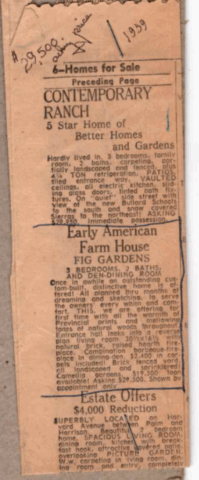The War Years: 1944 – 1945
Dad was stationed in San Diego and Mom, living in Los Angeles.
Mom and Dad met at a USO dance in Los Angeles. Dad turns to his navy buddy teasingly but volume is elevated so that he might be purposely overheard – “Oh they will never dance with us! They are so beautiful.” Within earshot, Mom and her girlfriend companion; “Why don’t you ask us, and find out?” came the retort.
In addition to dancing together they would watch horse and player polo matches or frequent the posh nightspot Coconut Grove in the Ambassador Hotel. “This was the place in the 1940’s. Freddie Martin’s orchestra was there at that time. My girlfriends and I would rendezvous for lunch by the pool on weekends.” Dad, on duty at San Diego’s Reim Field, would ride a northbound train, when on leave, to court Mom in Los Angeles. Dad would take the last night train to be back on base by morning for rollcall.
But on one occasion they ran into Dad’s Commanding Officer, Jack Lambert who was in charge of Dad’s flight squadron. Dad was supposed to have been on base in San Diego not out on the town with Mom in LA. Busted!
The Lambert family owned a Buick franchise in Oskaloosa and Mom had even dated Jack Lambert’s younger brother in her earlier life. Small world.
“I was employed in Los Angeles as executive secretary to the president and owner of the Filtex Corporation (a manufacturer of Electorlux vacuum cleaners and parts supplier for the war effort) when Rik and I met. “
Dad ships out.
Post War: 1946
Dad was released from active duty in the Navy 9 FEB 1946 at age 23 after having served for 37 mos.
Grandmother said just after Dad was born she took him out on the porch and the neighborhood kids came to see him. Someone asked his name and she told them Henrik. One boy automatically said “Hi Hank” to her baby. She felt insulted. She didn’t want a child named Hank. So from that time on the family called him by his middle name – Walt
“Rik was always called Walter or Walt until we met. When he told me his first name was Henrik (which I thought was much more enchanting) I informed him I was going to call him Rik, not Walt – and thereafter he identified himself as Rik, as eventually did his family.”
Proposal in Ford Model A
“So you may know the way we were – Rik’s proposal of marriage was much more romantic than I conveyed. Rik was a handsome navy pilot at the time and was wearing his olive [green] officer’s uniform except he had on cowboy boots. It was a lovely summer evening. As we approached Los Angeles on our late night return from the rodeo, we could see the lights of the city. We were on a traffic-less highway. Rik pulled the topless Model A coupe off the road so we could absorb from a hilltop the quiet beauty of the starry, starry night and delight in the twinkling lights of the city far below. It was enchanting. Rik’s proposal was a completely unexpected surprise. I graciously explained my desire to respond at a later date.”
“I never met Father Strom. He died in Tennessee where he had gone to get a job during World War II and where Mother Strom had joined him. Mother Strom moved to California, where both Rik and his brother Norman were stationed, after Father Strom died. Norman enrolled in UC Berkeley and Rik in UCLA extension classes under the GI Bill of Rights with tuition plus $90/month” (Mom too! UCLA Spanish class where she got an A)
Dad wanted to re-enlist full time in the Navy but there were not enough openings due to a post war scale down. When released from the Service Dad was delivering lumber, driving a truck in LA. Dad lived in a rented room or lived at his Mother’s in Gardena. Dad was hired as an apprentice by a carpenter contractor who saw that Dad was a hard worker.
“We were married in the Episcopal Church Chapel in Westwood Village.” Dad waited to hear from the Naval Reserve while Mom and Dad enjoyed an extended honeymoon traveling about the western USA.
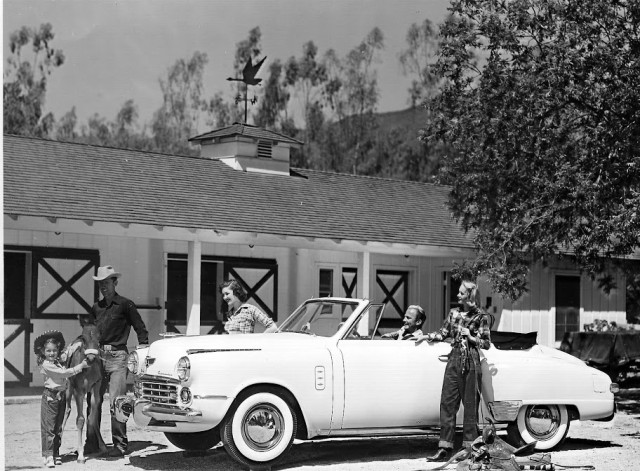
Dad managed horses at the North Hollywood Mandeville Canyon Oroweat Stables. Shown was Dad’s work location for a one off Esquire Magazine print ad during 1948. (Note Dad’s knee is helping to brace up the colt who would have liked to lay down) The original photo shoot had to be canceled because Dad had college classes that day. Dad was paid $25 for his part.
“We rented an apartment [2418 Oak St., Apt. 6] in Santa Monica. I was employed as a legal secretary with Teiste, Rohe, and Petty, a Beverly Hills law firm (one of their clients was the cowboy film star Roy Rogers).”
But by then, Dad had decided to attend school full time.
1947-1949
Mom and Dad left Los Angeles for San Francisco so that Dad could attend Hastings College of the Law
“Rik enrolled in the San Francisco law school and I was [attorney] Bruce Walkup’s legal secretary.”
Bruce Walkup. 220 Montgomery St
“We shared a suite of offices at One Montgomery Street with Hiram Johnson III whose grandfather was the Senator renowned for revising laws relating to the powerful railroad companies. As the first attorney to win a million dollar settlement against a railroad company in a personal injury case, Walkup founded the Million Dollar Club. To qualify for membership an attorney had to receive a minimum award of one million dollars for his/her client, which was a lot of money at the time.
It was great fun living in San Francisco. We had an apartment in a high rise building atop a hill on 1770 Pine Street and I would ride to and from work on the cable car (wearing a hat and white gloves – Grace Kelly style ).” Tennis anyone?
The Cowboy Years
1950-1952
“Rik unable to continue law school…” abandoned the idea to return to his true devotion “…we moved to Bakersfield where Rik could get a job at a meat packing company weighing livestock and cowboying.
Mom and Dad, window shopping, found a Pontiac model that they liked but they took delivery of their first new automobile, a 1950 Chieftain Deluxe Convertible from a dealer in Iowa. (Mr. Walkup loaned them the money). Mom, her brother Gaylord and his wife Mary, took the train to take delivery. After visiting Mom’s hometown they drove in it across the country together road trip style. Gaylord did the driving as Mom didn’t acquire a drivers license until several years later. (back home, and unlicensed, Mom managed to drive errands keeping to dirt roads through seldom trafficked Bakersfield oil fields)
- 120 inch WB
- Silver8streak 8 cylinders
- 268 ci
- 6.5:1 compression
- 108 hp @3600
- 220 torque @ 2200
- Hydramatic Drive (4 speeds)
- Solar Gold (or Saturn Gold)??
“I was employed as a secretary to a geologist (a Christian Scientist) who was vice president of the Midland Oil Company until I became delightedly pregnant as the mother-to-be”
There was a major earthquake (7.3) a few days after Clinton Einar was born; Mom and baby were still in hospital . Jump to speculation was that it had been a possible atomic attack – as per paranoia of that era.
Kern Valley Packing Company was a Rudnick owned meat packing house. Oscar and Libbie Rudnick were Lithuanian immigrants. For the next two years Dad was in charge of the cowboy work at their feedlot in Bakersfield and the weighing of sheep. ($240/month)
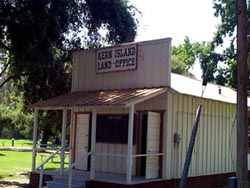
This preserved historic structure was a Rudnick cookhouse. It originally stood at 7100 South H Street in Bakersfield
The Rudnicks and their 4 sons were pioneers in the Kern County cattle and sheep industry. There were 11 offspring who continue in the family business today (Onyx Ranch which is East of Lake Isabella).
On occasion at Lost Hills, an area West of Bakersfield, there were 10 or 12 work crew from other various ranches pooled together one of whom queried Dad “…are you the best cowboy here?”
Dad was an authentic cowboy but keen to avoid possible provocation answered No… adding that he worked with some very talented people. As a for instance there was a cowboy he rode with by the name of Ed Connell, who later wrote a book HACKAMORE REINSMAN about horsemanship. The Tejon Ranch was nearby and the two had gathered cattle there.
A fist fight sometimes settled challenges (Dad was a boxing champ in Navy training) and at one point he did duke-it-out with a cowhand employee who wouldn’t be reasoned with. He said to the guy: “… no I don’t want to hurt ya, are you sure you want to fight?” and yes they did.
On many of his weekends off, Dad was required to assist the Rudnick sons, who owned other ranches. Dad was expected to help out for no extra pay. Typically, he had to milk his own cow first (starting at 02:00) then show at 03:00 to work all day long before returning home to be at his regular job by 06:00 on the Monday following. “I could never do that again today but at the time that was part of the job” But this was a constant source of friction and Rudnick’s son perceived Dad as his rival.
Mom and Dad resided in a rented cottage in Bakersfield. They had a Hereford Cow that had lost its calf but she was still giving milk. The extra milk was used for leppy (abandoned or orphaned) calves that Dad would bring home to a vacant lot across from the house to be bottle fed. Mom would prepare the raw buckets of milk to sustain them. There was an ornamental lamb or two in their fenced yard that “would eat the shrubbery and anything else that they could reach”.
1953-1954
“We moved to the Harney Ranch in Livingston, where I became delightedly pregnant as mother-to-be of Mark Lindsey. The plan was to have two children two years apart in age. As a consequence of Rik being fired, we moved every two years of the first ten years of our marriage – such a bummer.”
The Harney Ranch was to the West of Merced. Dad began work there overseeing 6000 acres with 1,400 head of Hereford and Angus cows.
Today this property is owned by Joe Gallo. Charles Harney was a contractor from San Francisco. His legacy was Candlestick Park which he built. The site at Candlestick Point was chosen because the city already owned 31 acres there. The city bought an additional 41 acres at an [absurd] cost of $2.7 million from Charles Harney who, in a sweetheart deal (32-40% higher than fair market value, according to the December 1958 Grand Jury Report), also became the stadium contractor. http://www.foundsf.org/index.php?title=Candlestick_Swindle
Mom and Dad were furnished a new ranch style house while Dad was made supervisor, however without increase in pay.
In a reminisce Dad said he would “swim my horse across the San Joaquin River to San Joaquin Island”
Harney was a difficult man and could be outright mean. In one notorious incident Harney pulled a shotgun on some men keen on hunting. There was an easement across his land and so the hunters were within their rights but ‘ornery Harney just didn’t care for them traversing it anyway.
After a major dispute with this “clueless” boss over [operational] methods for getting tasks done Dad had to say “no way” to him. There was a heated temper blow-up and Harney fired Dad on the spot.
1955 – 1956
Noble Feedlot – We lived onsite in a company provided house, Dad was manager of all cowboy operations. Dad was overseen by Bob Smith until Dad was replaced by one Charlie Hein who managed the feedlot operation. Herb Little was another divisional manager there.
William H Noble (1891-1973) – Noble Land and Cattle Company 8105 S Lassen Ave. San Joaquin, CA off of Manning Ave. Current day the enterprise as been divided and the land sold off. The feed yard is now Standard Cattle Company and the old Cattle Headquarters belongs to Terranova. [map]
Cattleman Years
“Then, J. E. “Gene” Harbinson provided the seed capital for Rik to buy cattle for fattening in Noble feedlot for one year on a fifty/fifty sharing of profit or loss basis. [Estee] provided all the accounting services and prepared and filed the partnership income tax return without remuneration. Fortunately, the price of cattle began going uppity up up – no matter at what price the animal was purchased, it sold for a higher price.”
1956
Moved to Fresno; rented house on Millbrook – Clint began Kindergarten
1957
Moved to Kerman; rented house – Clint re-started Kindergarten mid-year at Kerman Floyd Elementary School and also attended 1st grade there.
700 S 1st St
1958 – 1959
Dad began a cattle feeding business independently.
“Thereafter [beginning with year 1958 and this time sans business partner], financing was procured from Crocker Bank and later, the Bank of America (when a loan was based upon a handshake) Rik began buying and feeding cattle for our own account and I provided all the business administration and accounting services.”
Moved back to Fresno in 1959 to 815 E Alamos Ave
$29,500 was the asking price in 1959. Our offer of $25,000 was accepted. The interest rate was 6% Attached is a copy of the ad. The house located in Fig Garden (Fresno County) was purchased – 2nd grade for Clint, Kindergarten for Mark at the Bullard Elementary School.
As a cattleman, Dad along with Doug White a cattle buyer (commission man) drove down to Hermosillo, Mexico to look at cattle. You couldn’t do business in Mexico without a Mexican National as agent so one went along to act as a go between. A representative sample that they previewed were shorthorn Hereford steers. They had been grass fed and would put on weight in the feed yard back home. He put up a deposit on 1,000 steers. Dad would return weeks later, after they had been gathered from the range, to make final payment. But when he returned, the Herefords were absent, and instead a different bunch substituted. There was little that could be done. Business in Mexico was a risk in that way. You completed the purchase or sacrificed your deposit ($10k). Over a barrel. Dad bought the scrawny heard and saw them weighed and loaded onto Mexican rail cars. They drove the 100 mile dirt roads back to the border to wait in Nogales for the freight train to arrive. From there the steers were reloaded onto US cattle trucks for the 36 hour final journey to a feedlot in central California. That was the first and last time that Dad did a transaction in Mexico although despite all, a profit was made.
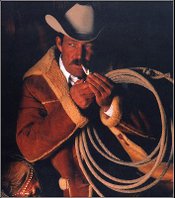
On that Mexico trip Dad bought two pairs of hand made silver spurs from a Mexican saddle shop for $5 each. Where are those spurs today? He lost a spur on a ranch ride years later (which was found and returned to him). He gave the other pair to his cowhand friend Darrell Winfield, who eventually found fame as the original Marlboro Man.
In the end, a ranch help employee liberated [stole] Dad’s pair from the saddle tack room.
1970 – 2008
Sandy Mush Ranch – (4831 W Sandy Mush Rd, Merced)
About 800 acres of deep water well irrigated permanent pasture. Suitable for a (beef and not to be confused with dairy) cow breeding operation Mom and Dad had become risk averse and at this juncture the family pivoted from lucrative steer herd to brood cows with calves. Hereford at first then Angus were added. This evolved to Brangus – crossbred Angus with Brahma (50/50),
Crossbred Charolais and Brangus.
Lastly, and until Dad retired, purebred Limousin ~300 head
Horses Owned
- Two Bits
- Salty (Salty was a wedding gift from Dad to Mom boarded in San Francisco but left behind when they moved to Bakersfield. Dad went back for the horse but the caretaking arrangement with a local Physician had been vague and Dad could not get the horse back. (Mom inspired the spice naming convention)
- Paprika
- Coca Malt
- Nutmeg
- Cinnamon
- Rocky
- Shotgun
- Shinny
- Sancho (named after ‘Sancho, the Homing Steer’ in a 1962 Disney episode)
- Bullet (acquired from Bud and son Roger Swift, friends who helped with cowboy work)
- Blue Bell
“Sold to Little Rik!” boomed over the Visalia Sale Yard PA – Mark, a youngster, was sitting on Dad’s lap and waving his arm to clear the air of cigar smoke which the light hearted auctioneer purposely mistook for an actual gesture to bid. Afterward some convivial discussion with the auction house people and the 5 head of steers were acquired. Clint and Mark were in the cattle business.
Farming
1962 –
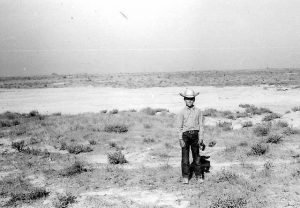
The Kerman Ranch aka Section 30 acreage located to the South of Kerman was purchased from William Noble. It was arid and alkali undeveloped ground with range grass, sage and tumble weed cover. The land was leveled and one deep water well established making it farmable. Initially custom farmed for us by Jack Cardwell and son, Herc, the first Alfalfa harvest came in 1963. Cotton was also planted here. Industry and government programs limit cotton acreage so intermittently we have also rotationally grown Wheat, Corn, Sugar Beets, Carrots, and Tomatoes.
Following Dad’s retirement circa 1998 our property was leased to a tenant farmer who improved the land by planting an almond orchard, a vineyard, and by drilling a second Well and installing a Drip irrigation. A promising start but, in 2001 the tenant, over extended, having poor financial footing, and failing to perform contractually was evicted by Mom and Mark offering his legal assistance. The timing was fortuitous because should the tenant’s bank have foreclosed before the eviction, our lease agreement and property enhancement would have gone to his lender.
Mom stepped up to salvage the enterprise. On the plus side we had won an orchard, an asset, but the neglected 16,000+ trees were in very sorry condition. The global market for grapes was in a state of collapse and the vines were a wreck, so the entire vineyard had to be scraped and removed. Thanks to Mom, a professional ranch manager Don Cameron, with whom she contracted, rose to the challenge, and was able to restore the forsaken trees to life.
1972 – 2002
A direct effect of the first US energy crisis was a significant increase in our cost of water (think electric utility rates). Our cow and calf business model at the Sandy Mush Ranch was turned upside down. Farming promised a viable return on investment.. New agricultural equipment was purchased and cotton was planted at the Sandy Mush Ranch.This crop became a significant focus until the Sandy Mush Ranch was sold.
2008
Mom organized a California Limited Liability Company including Clint and Mark as LLC members.
2011
New vineyard established. Due to lackluster breakeven commodity prices for typical annual row crops previously farmed in the former (triangle field) vineyard, there was consensus to establish a new permanent vineyard. That acreage was redeveloped and 44,052 Muscat of Alexandria #3 grafted to Kober 5BB rootstock were planted.
1998 – 2002 Jag Paul, tenant
2002 – 2012 Don Cameron of TRI – farm manager
2012 – Cory Edwards of WAgE – farm manager
2013 – first wine grape harvest
2022 – Almond orchard trees removed and replanted with Muscat and Chardonnay wine grapes
Loose Ends…
Quien Sabe Ranch – Tres Pinõs, CA (Doug White) bought a bay horse
Fort Laramie? – Dad took care of the Polo ponies
Earl Vandehei (Ranch) – Cheyenne WY – Dad drove a team of horses from behind a Fresno Plow in the gravel pit just before WWII
Jack Schwabacher – Central California
Roger Swift – “hot branding iron/cold shovel” story…
George Lordson – did cowboy work for Dad in Kerman
Darel Winfield and an on horseback sprint race challenge…
Avon Davis was a breeder of Brahma bulls and a good friend of Dad
Tulare Sale Yard
Visalia Sale Yard
Atwater Livestock Auction – off of Hwy 99 (burned to ground in 2004)
Raymond Ranch – Madera County
Rauch Ranch – 3 or 4 years leased in Mariposa – 600 cows and calves 6000 acres. Phil Roush. Gathering in April or May the cows would get half wild. “a few cow holdouts managed to stay behind and were as wild as deer in the brush and trees. hard to ride your horse in there”. Cows went on permanent pasture in the summer. Rattlesnake country – tree limb brushed off his hat. had to wait for big snake to clear off before he could retrieve it. Ben Hur Road from Raymond. aqua fria rd route 140 via planada right on Auga Fria runs in to ben hur ?? 3396 Ben Hur Rd, Mariposa, CA 95338
